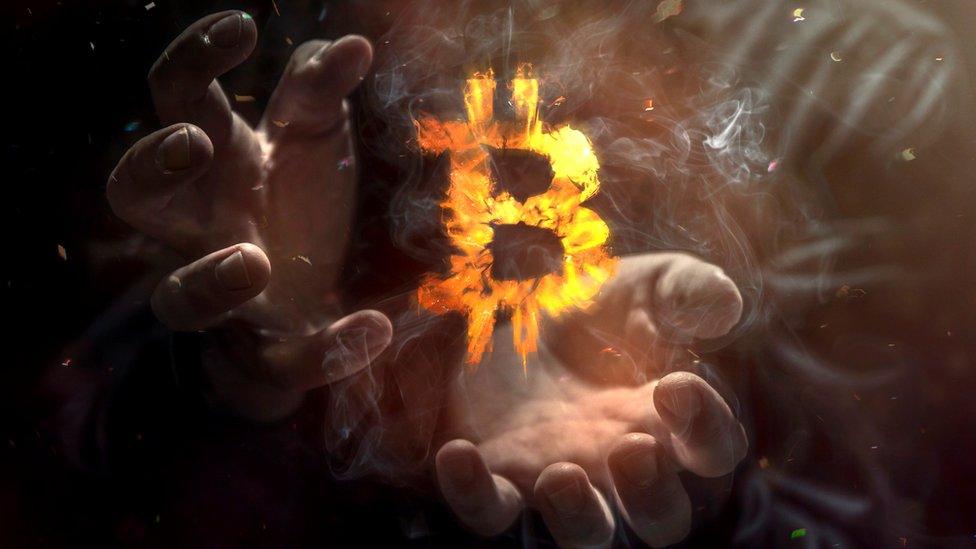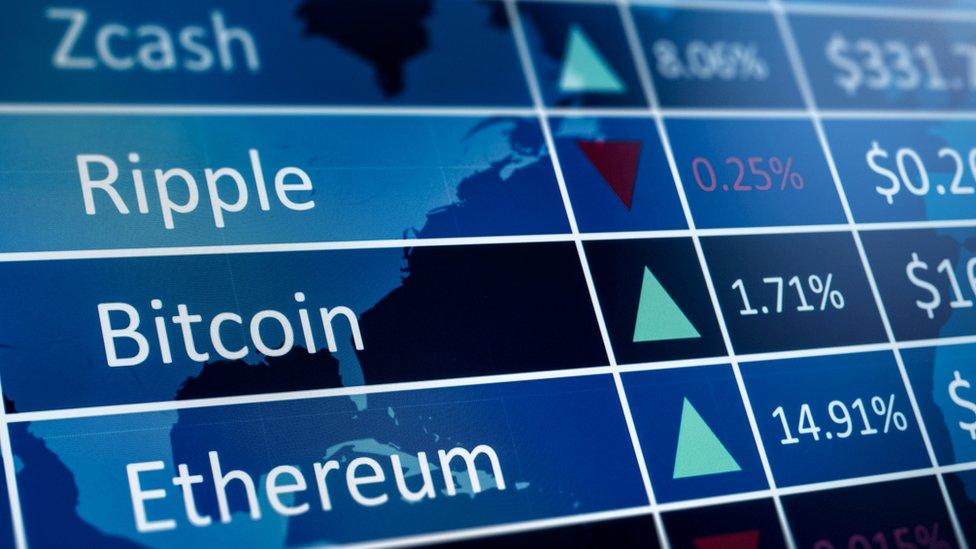Bitcoin buster? The search for a more stable cryptocurrency
- Published

Bitcoin's price has been extremely volatile over the last 12 months
Cryptocurrencies - digital tokens known as cryptos for short - have investors in the grip of a gold rush fever, with billions being traded every day. Prices fluctuate wildly, making them high-risk investments. But could a more stable, less volatile crypto persuade us to think of digital money less as a speculative investment and more as a mainstream "smart" currency?
There are now more than 1,500 cryptos - Bitcoin, Bitcoin Cash, Ethereum, Litecoin to name just a few - being traded on about 190 exchanges around the world.
Prices have soared and crashed alarmingly. In 2017 the price of a bitcoin rocketed to nearly £15,000 before losing two-thirds of its value in just a few months. It's currently worth about £5,000.
This volatility may be a speculative trader's friend, but it has reinforced cryptos' reputation for being high-risk investments for the adrenalin-fuelled "get rich quick" brigade.
Crypto fundraising schemes, known as Initial Coin Offerings, have alarmed regulators around the world.
Carney calls for crypto-currency regulation
So a growing number of crypto start-ups are developing alternatives known as stablecoins, digital tokens pegged to traditional fiat currencies such as the US dollar, British pound or Japanese yen, with the aim of reducing this volatility and increasing confidence.
Hong Kong-based Tether has blazed a trail in this market, swapping about $2.7bn (£2.1bn) worth of fiat currency into its eponymous digital tokens. It claims to have all its digital tethers backed by traditional money in its bank accounts - a claim that has been disputed by some.
But Tether's 90% dominance of the stablecoin market is enticing several others to try something similar.
For example, crypto finance company Circle is launching a new token called USD Coin.
"Imagine a US dollar coin that you can make payments with, use on crypto networks, or use in smart contracts to pay dividends, but which you can convert back to fiat currency at any time," explains Circle chief executive Jeremy Allaire.
Circle's USD Coin will run on the Ethereum blockchain - the distributed ledger technology underlying cryptos - and have an open standard infrastructure overseen by a body called Centre. It wants Centre to become the main platform for other stablecoin operators.

Cryptocurrencies' trading prices have been extremely volatile
"Crypto represents the next layer of infrastructure for the internet," he says. "It will allow money to move at the speed of light around the world for free, but also offer binding, verifiable contracts, enabling anyone to do business together.
"We're going to see a lot of businesses using tokens for revenue raising. And eventually central banks will want to do this," maintains Mr Allaire.
Circle, which is backed by the likes of Goldman Sachs and Baidu and has an estimated value of close to $3bn, recently attracted another $110m in investment led by investors such as Chinese crypto mining giant Bitmain.
Kory Hoang is the founder of Stably, a firm in Vancouver that is developing StableUSD, another US dollar-backed stablecoin. The Vietnam-born entrepreneur believes the sector presents "a huge opportunity", especially for people in countries with unstable currencies.

Will cryptos ever replace traditional currencies?
"Fruit sellers on the streets in Zimbabwe could accept your digital payment via an app," he says. "Their fiat money is almost worthless, but they could receive tokens in seconds and sell them very easily for a small commission."
Obi Nwosu, founder and chief executive of Coinfloor, a crypto exchange collective, says: "There are about two billion people who are unbanked or underbanked, which means they have no access to the world of e-commerce.
"Bitcoin and cryptos give these people access at much lower cost, but admittedly with less protection."
What price stability?
But there is disagreement within the industry about the best way to reduce the price volatility of cryptos.
Coinfloor hopes to solve the volatility issue by attracting far more money into the sector in the belief that greater trading volumes will lead to a more efficient market.
This will require better regulation, argues Mr Nwosu, before large institutions are likely to commit serious money. Concerns about the abuse of cryptos for money laundering and terrorist financing remain a barrier to mass acceptance, he says.
But this is still better than going down the stablecoin route, he believes, which requires a central organisation to back the digital tokens, with the extra cost this entails. And this structure conflicts with the decentralised nature of cryptos and blockchain technology and could be "the worst of both worlds", he says.

More Technology of Business

"We think that although stablecoins could be popular in the short run, a decentralised currency that is stable and doesn't have a central organisation behind it will be safer in the long run."
Whatever the disagreements about how to achieve price stability for currency and investment purposes, most people in the sector agree that a crypto's additional ability to act as a smart contract presents huge opportunities to "tokenise" physical assets.
"Say I have a house in downtown Saigon worth $1m," says Mr Hoang. "I could tokenise it and sell those tokens on the global crypto market. You could issue a billion pieces of your house if you wanted. Then people would start trading them, just like shares in a real estate investment trust.
"It gives investors around the world access to investment opportunities they never had before."
Akbar Thobani, chief executive of crypto trading platform SFOX, says: "We think that tokenising assets, such as trucks, cars, planes and real estate, will become big business."
But if stablecoin cryptos do become as mainstream as fiat currencies, will the system be able to cope with the volume?
Many fear blockchain is getting slower and in danger of seizing up altogether. Ethereum, one of the most popular blockchain platforms, is only able to process about 13 transactions a second, whereas card payment processing platform Visa can cope with more than 20,000 transactions a second.
This is why work is afoot to create more flexible blockchain-based platforms, such as EOS and Stellar, that could cope with a vast increase in transaction volume and millions more users.
Follow Technology of Business editor Matthew Wall on Twitter, external and Facebook, external